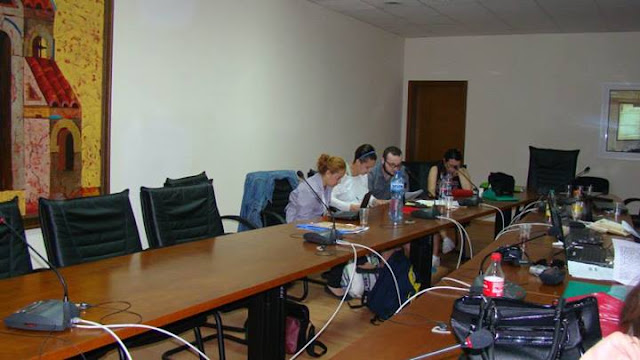петък, 2 август 2013 г.
събота, 20 юли 2013 г.
DEVELOPMENT OF EARLY OTTOMAN ARCHITECTURE ON BULGARIAN TERRITORY. MAHMUD BEY’S IMARET IN IHTIMAN - Alexander Antonov
The present article focuses on one of the imarets in
the Bulgarian lands – that of Mahmud Bey in Ihtiman. For the study of its
establishment, development and architecture, Ottoman narratives and registers,
documents of the National Institute for Immovable Cultural Heritage, and field
research have been used. The main goal is to study the architectural
characteristics of a forgotten piece of early Ottoman architecture, hardly
researched so far, which marks the beginning of urbanization of today’s town of
Ihtiman.
The imaret in Ihtiman
belongs to early Ottoman architecture on the Bulgarian territory and shows both
the continuity in construction techniques and decorations with the
Balkan-Byzantine tradition, and the new architectural tendencies in the
urbanization of conquered lands. The purpose of this newly constructed building
was to appropriate for Islam a newly sprung settlement on the Diagonal road,
strategically important for communication.
PEACE IN THE HOUSE OF JACOB. A Few Remarks on the Ideology of Two Biblical Themes in the Oration ‘On the Treaty with the Bulgarians’ – Assist. Prof. Dr. Kirił Marinow
Who were the Byzantines and the Bulgarians according
to the Byzantine point of view? What did connect or divide them?
This paper studies the ideological background of the
relationship between the Byzantines and the Bulgarians, their political,
religious and, of course, everyday life. The way of life in which the peace was
the basis of the human’s everyday life, and war was a disturbance, violence
which destroyed the holy order of every time repeating circle of time, circle
which guaranteed safeness.
We could called it – standards of coexistence (the
basis of the relationships between these medieval societies, the way which
would have to characterize their relations, would have to become their common
way of living). From the sociological and anthropological point of view the
abovementioned standards of coexistence between the Byzantines and Bulgarians
would have to influence their everyday life in its whole spread too.
TOPOI OF URBAN SPACE – TARNOVO IN THE 19TH CENTURY – Assist. Prof. Dr. Gergana Georgieva
I
would like to trace the development of the urban space and urban structure –
how it changed in different centuries and in different periods on the basis of
mixture of Bulgarian, Western and Ottoman Turkish sources.The
confirmation of Tarnovo as important urban center became in the 12th
c., when it turned to capital of the Bulgarian kingdom. Its initial core was
Tsarevets, Trapezitsa and the neighborhoods between them. After the Ottoman
conquest, the medieval center was occupied by Muslim neighborhoods. The town
developed and spread, from east to west. New quarters appeared and the core
moved from Tsarevets to the so called Old town – mainly around the Konak – the
seat of the Ottoman governor (nowadays known also as the National Assembly). In
the 19th c. there were 14 Muslim mahalles in Tarnovo with 872
households and 22 mosques in it and 10 non-Muslim mahalles with 12 churches.
TRADITIONAL POPULAR COSMETIC PRACTICES – HEALTH, HYGIENE OR STRIVING FOR BEAUTY - Assist. Prof. Iliyana Gancheva
The problem of traditional popular
cosmetic practices is a multi-layered one. Without covering all its complexity,
I will discuss those means, which traditional Bulgarians used in their quest
for the coveted beauty, health and cleanliness. Despite the imposition of
modern cosmetics and procedures, from the second half of the twentieth century
to these days, many of them still find their applicability. Traditional popular
cosmetics could be viewed from two perspectives – those related to the
mythology of the Bulgarians, on the one hand, and on the other, those based on
popular knowledge and experience invariably associated with traditional popular
medicine.
If we have to make sexual differentiation, the
indisputable fact is that women by all the observers of the life in villages
and towns. The advantage of women, undoubtedly is due to their desire to be
beautiful, to the care for maintaining long hair, and also to their greater
cleanliness. In connection with male cosmetics, particular
attention should be pay to shaving. Beard
was a symbol was an essential element of Bulgarian popular mythology, as it was
considered a very important attribute in making charms. For example, when
shaving the groom special care was taken to gather all the hairs because they
could be used for magic.
THE BREAD OF THE BULGARIANS IN THE MIDDLE AGES - Assoc. Prof. Dr. Ivan Lazarov
Wheat was the most widely spread and esteemed cereal
not only in medieval Bulgaria but all over the Balkans as well. Byzantine,
Venetian and Genoese documents from the 11th – 14th centuries
give evidence that Bulgarian grain was exported through the Black Sea ports
predominantly to Constantinople but Italian merchants traded Bulgarian wheat to
more distant ends of Europe.
People used to start wars for wheat and it was considered strategic raw material.
People used to start wars for wheat and it was considered strategic raw material.
Bread reaches the table after a long, hard and full of
uncertainties labour. Bread is sacred and that is why it was considered a sin
to throw away even the crumbs.
What was the bread of the Bulgarians like in the
Middle Ages and how was it prepared?
петък, 19 юли 2013 г.
Абонамент за:
Коментари (Atom)




















































